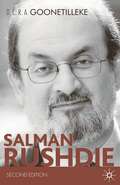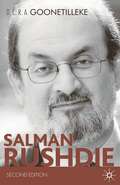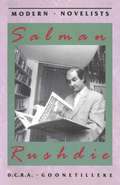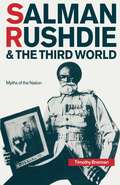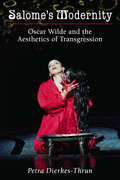- Table View
- List View
Salinger's The Catcher in the Rye: A Routledge Study Guide (Reader's Guides)
by Sarah GrahamJ. D. Salinger's 1951 novel, The Catcher in the Rye, is the definitive coming-of-age novel and Holden Caulfield remains one of the most famous characters in modern literature. This jargon-free guide to the text sets The Catcher in the Rye in its historical, intellectual and cultural contexts, offering analyses of its themes, style and structure, and presenting an up-to-date account of its critical reception.
Sallust's Bellum Catilinae (Society for Classical Studies Texts & Commentaries)
by J. T. RamseyIn his Bellum Catilinae, C. Sallustius Crispus or Sallust (86-35/34 B.C.) recounts the dramatic events of 63 B.C., when a disgruntled and impoverished nobleman, L. Sergius Catilina, turned to armed revolution after two electoral defeats. Among his followers were a group of heavily indebted young aristocrats, the Roman poor, and a military force in the north of Italy. With his trademark archaizing style, Sallust skillfully captures the drama of the times, including an early morning attempt to assassinate the consul Cicero and two emotionally charged speeches, by Julius Caesar and Cato the Younger, in a senatorial debate over the fate of the arrested conspirators. Sallust wrote while the Roman Republic was being transformed into an empire during the turbulent first century B.C. The Bellum Catilinae is well-suited for second-year or advanced Latin study and provides a fitting introduction to the richness of Latin literature, while also pointing the way to a critical investigation of late-Republican government and historiography. Ramsey's introduction and commentary bring the text to life for Latin students. This new edition (updated since the 2007 printing) includes two maps and two city plans, an updated and now annotated bibliography, a list of divergences from the 1991 Oxford Classical Text of Sallust, and revisions in the introduction and commentary.
Sallust's Bellum Catilinae (Society for Classical Studies Texts & Commentaries)
by J. T. RamseyIn his Bellum Catilinae, C. Sallustius Crispus or Sallust (86-35/34 B.C.) recounts the dramatic events of 63 B.C., when a disgruntled and impoverished nobleman, L. Sergius Catilina, turned to armed revolution after two electoral defeats. Among his followers were a group of heavily indebted young aristocrats, the Roman poor, and a military force in the north of Italy. With his trademark archaizing style, Sallust skillfully captures the drama of the times, including an early morning attempt to assassinate the consul Cicero and two emotionally charged speeches, by Julius Caesar and Cato the Younger, in a senatorial debate over the fate of the arrested conspirators. Sallust wrote while the Roman Republic was being transformed into an empire during the turbulent first century B.C. The Bellum Catilinae is well-suited for second-year or advanced Latin study and provides a fitting introduction to the richness of Latin literature, while also pointing the way to a critical investigation of late-Republican government and historiography. Ramsey's introduction and commentary bring the text to life for Latin students. This new edition (updated since the 2007 printing) includes two maps and two city plans, an updated and now annotated bibliography, a list of divergences from the 1991 Oxford Classical Text of Sallust, and revisions in the introduction and commentary.
Salman Rushdie: Contemporary Critical Perspectives (Contemporary Critical Perspectives)
by Robert Eaglestone Martin McQuillanSir Salman Rushdie is perhaps the most significant living novelist in English. His second novel, Midnight's Children, is regularly cited as the 'Booker of Bookers' and its impact is still being felt throughout in world literature. His fourth novel, The Satanic Verses, led to the 'Rushdie Affair' certainly the most significant literary-political event since the Second World War. Rushdie has continued to produce challenging fiction, controversial, thought-provoking non-fiction and has a presence on the world stage as a public intellectual. This collection brings together leading scholars to provide an up-to-date critical guide to Rushdie's writing from his earliest works up to the most recent, including his 2012 memoir of his time in hiding, Joseph Anton. Contributors offer new perspectives on key issues, including: Rushdie as a postcolonial writer; Rushdie as a postmodernist; his use and reuse of the canon; the 'Rushdie Affair'; his responses to 9/11 and to the 'War on Terror'; and issues of more complex philosophical weight arising from his fiction.
Salman Rushdie: Contemporary Critical Perspectives (Contemporary Critical Perspectives #13)
by Robert Eaglestone Martin McQuillanSir Salman Rushdie is perhaps the most significant living novelist in English. His second novel, Midnight's Children, is regularly cited as the 'Booker of Bookers' and its impact is still being felt throughout in world literature. His fourth novel, The Satanic Verses, led to the 'Rushdie Affair' certainly the most significant literary-political event since the Second World War. Rushdie has continued to produce challenging fiction, controversial, thought-provoking non-fiction and has a presence on the world stage as a public intellectual. This collection brings together leading scholars to provide an up-to-date critical guide to Rushdie's writing from his earliest works up to the most recent, including his 2012 memoir of his time in hiding, Joseph Anton. Contributors offer new perspectives on key issues, including: Rushdie as a postcolonial writer; Rushdie as a postmodernist; his use and reuse of the canon; the 'Rushdie Affair'; his responses to 9/11 and to the 'War on Terror'; and issues of more complex philosophical weight arising from his fiction.
Salman Rushdie: Second Edition (Palgrave Modern Novelists Ser.)
by D C GoonetillekeThis updated and expanded new edition reviews Rushdie's novels in the light of recent critical developments. It also features new chapters which examine the author's latest works including Fury (2001), Shalimar the Clown (2005) and The Enchantress of Florence (2008), bringing coverage of this important British author up to the present.
Salman Rushdie: Second Edition
by D. C. GoonetillekeThis updated and expanded new edition reviews Rushdie's novels in the light of recent critical developments. It also features new chapters which examine the author's latest works including Fury (2001), Shalimar the Clown (2005) and The Enchantress of Florence (2008), bringing coverage of this important British author up to the present.This updated and expanded new edition reviews Rushdie's novels in the light of recent critical developments. It also features new chapters which examine the author's latest works including Fury (2001), Shalimar the Clown (2005) and The Enchantress of Florence (2008), bringing coverage of this important British author up to the present.
Salman Rushdie (Palgrave Modern Novelists Series)
by D.C.R.A. GoonetillekeIn this valuable study of Salman Rushdie, currently the world's most controversial writer, Professor Goonetilleke examines 'the Rushdie affair', but his focus is on Rushdie as a novelist. He considers Rushdie's fiction as art, tracing the collage of autobiographical and historical elements and analyses Rushdie's complex position as a migrant writer, drawing on the cultural riches of two hemispheres while not belonging fully to either. Rushdie emerges as the most important and innovative novelist in English since World War II.
Salman Rushdie: Fictions of Postcolonial Modernity (New British Fiction)
by Stephen MortonThis introduction places the fiction of Salman Rushdie in a clear historical and theoretical context. Morton explores Rushdie's biography, the histories that inform his major works and his relevance to contemporary culture. Including a timeline of key dates, this study offers an overview of the varied critical reception Rushdie's work has provoked
Salman Rushdie: Fictions of Postcolonial Modernity (New British Fiction)
by Stephen MortonThis introduction places the fiction of Salman Rushdie in a clear historical and theoretical context. Morton explores Rushdie's biography, the histories that inform his major works and his relevance to contemporary culture. Including a timeline of key dates, this study offers an overview of the varied critical reception Rushdie's work has provoked
Salman Rushdie: The Essential Guide (Vintage Living Texts #11)
by Jonathan Noakes Margaret ReynoldsIn Vintage Living Texts, teachers and students will find the essential guide to the works of Salman Rushdie. Vintage Living Texts is unique in that it offers an in-depth interview with Salman Rushdie, relating specifically to the texts under discussion. This guide deals with Rushdie's themes, genre and narrative technique,and a close reading of the texts will provide a rich source of ideas for intelligent and inventive ways of approaching the novels.Also included in this guide are detailed reading plans for all three novels, questions for essay and discussion, contextual material, suggested texts for complementary and comparative reading, extracts from reviews, a biography, a bibliography and a glossary of literary terms.Texts covered: Midnight's Children, Shame and The Satanic Verses.Whether a teacher, student or general reader, the Vintage Living Texts series gives you the chance to explore new resources and enjoy new pleasures.
Salman Rushdie and Indian Historiography: Writing the Nation into Being
by Nicole Weickgenannt ThiaraPaying particular attention to the representation of women and to gendered notions of the nation, this book examines for the first time the marked parallels between Rushdie's critique of the Nehruvian legacy and the most significant recent trends in Indian historiography, especially the feminist and subalternist movements.
Salman Rushdie and the Genesis of Secrecy
by Vijay MishraSalman Rushdie and the Genesis of Secrecy is the first book to draw extensively from material in the Salman Rushdie archive at Emory University to uncover the makings of the British-Indian writer's modernist poetics. Simultaneously connecting Rushdie with radical non-Western humanism and an essentially English-European sensibility, and therefore questions about world literature, this book argues that a true understanding of the writer lies in uncovering his 'genesis of secrecy' through a close reading of his archive. Topics and materials explored include unpublished novels, plays and screenplays; the earlier versions and drafts of Midnight's Children and its adaptations; understanding Islam and The Satanic Verses; the influence of cinema; and Rushdie's turn to earlier archives as the secret codes of modernism. Through careful examination of Rushdie's archive, Vijay Mishra demonstrates how Rushdie combines a radically new form of English with a familiarity with the generic registers of Indian, Arabic and Persian literary forms. Together, these present a contradictory orientalism that defines Rushdie's own humanism within the parameters of world literature.
Salman Rushdie and the Genesis of Secrecy
by Vijay MishraSalman Rushdie and the Genesis of Secrecy is the first book to draw extensively from material in the Salman Rushdie archive at Emory University to uncover the makings of the British-Indian writer's modernist poetics. Simultaneously connecting Rushdie with radical non-Western humanism and an essentially English-European sensibility, and therefore questions about world literature, this book argues that a true understanding of the writer lies in uncovering his 'genesis of secrecy' through a close reading of his archive. Topics and materials explored include unpublished novels, plays and screenplays; the earlier versions and drafts of Midnight's Children and its adaptations; understanding Islam and The Satanic Verses; the influence of cinema; and Rushdie's turn to earlier archives as the secret codes of modernism. Through careful examination of Rushdie's archive, Vijay Mishra demonstrates how Rushdie combines a radically new form of English with a familiarity with the generic registers of Indian, Arabic and Persian literary forms. Together, these present a contradictory orientalism that defines Rushdie's own humanism within the parameters of world literature.
Salman Rushdie and the Third World: Myths of the Nation
by Timothy BrennanThe dialectic between national literary production and the rise of a group of writers with cosmopolitan sympathies is the aim of this book, concentrating on Rushdie's novels and journalism.
Salman Rushdie and Translation
by Jenni RamoneSalman Rushdie's writing is engaged with translation in many ways: translator-figures tell and retell stories in his novels, while acts of translation are catalysts for climactic events. Covering his major novels as well as his often-neglected short stories and writing for children, Salman Rushdie and Translation explores the role of translation in Rushdie's work. In this book, Jenni Ramone draws on contemporary translation theory to analyse the part translation plays in Rushdie's appropriation of historical and contemporary Indian narratives of independence and migration.
Salman Rushdie and Translation (Continuum Literary Studies)
by Jenni RamoneSalman Rushdie's writing is engaged with translation in many ways: translator-figures tell and retell stories in his novels, while acts of translation are catalysts for climactic events. Covering his major novels as well as his often-neglected short stories and writing for children, Salman Rushdie and Translation explores the role of translation in Rushdie's work. In this book, Jenni Ramone draws on contemporary translation theory to analyse the part translation plays in Rushdie's appropriation of historical and contemporary Indian narratives of independence and migration.
Salman Rushdie in the Cultural Marketplace
by Ana Cristina MendesTaking up the roles that Salman Rushdie himself has assumed as a cultural broker, gatekeeper, and mediator in various spheres of public production, Ana Cristina Mendes situates his work in terms of the contemporary production, circulation, and consumption of postcolonial texts within the workings of the cultural industries. Mendes pays particular attention to Rushdie as a public performer across various creative platforms, not only as a novelist and short story writer, but also as a public intellectual, reviewer, and film critic. Mendes argues that how a postcolonial author becomes personally and professionally enmeshed in the dealings of the cultural industries is of particular relevance at a time when the market is strictly regulated by a few multinational corporations. She contends that marginality should not be construed exclusively as a basis for understanding Rushdie’s work, since a critical grounding in marginality will predictably involve a reproduction of the traditional postcolonial binaries of oppressor/oppressed and colonizer/colonized that the writer subverts. Rather, she seeks to expand existing interpretations of Rushdie’s work, itineraries, and frameworks in order to take into account the actual conditions of postcolonial cultural production and circulation within a marketplace that is global in both orientation and effects.
Salman Rushdie in the Cultural Marketplace
by Ana Cristina MendesTaking up the roles that Salman Rushdie himself has assumed as a cultural broker, gatekeeper, and mediator in various spheres of public production, Ana Cristina Mendes situates his work in terms of the contemporary production, circulation, and consumption of postcolonial texts within the workings of the cultural industries. Mendes pays particular attention to Rushdie as a public performer across various creative platforms, not only as a novelist and short story writer, but also as a public intellectual, reviewer, and film critic. Mendes argues that how a postcolonial author becomes personally and professionally enmeshed in the dealings of the cultural industries is of particular relevance at a time when the market is strictly regulated by a few multinational corporations. She contends that marginality should not be construed exclusively as a basis for understanding Rushdie’s work, since a critical grounding in marginality will predictably involve a reproduction of the traditional postcolonial binaries of oppressor/oppressed and colonizer/colonized that the writer subverts. Rather, she seeks to expand existing interpretations of Rushdie’s work, itineraries, and frameworks in order to take into account the actual conditions of postcolonial cultural production and circulation within a marketplace that is global in both orientation and effects.
Salman Rushdie's Cities: Reconfigurational Politics and the Contemporary Urban Imagination
by Vassilena ParashkevovaEmploying Salman Rushdie as a guide to a historicized contemporary, this study offers an interdisciplinary exploration of the plurality of cities along his transnational trajectory. It engages with the geographically identifiable Bombay, Karachi, Islamabad, London or New York; the phantasmal, politically coded, Jahilia or Mildendo, the inspirational yet flawed urban precedents of Fatehpur Sikri or Renaissance Florence and the ways these cities generate, interact with and transform each other. Â The book situates Rushdie's cities in relation to developments in Bombay, Karachi, Islamabad and London writing and focuses on novels which shuttle between cities. Parashkevova attends to cities' cultural and historical contexts, to many of Rushdie's numerous literary, cinematic and artistic influences and to diverse events, processes and paradigms - earthquakes, translations, seductions - that politically re-position cities and citizens on the contemporary urban map.
Salman Rushdie's Cities: Reconfigurational Politics and the Contemporary Urban Imagination (Continuum Studies In The City Ser.)
by Vassilena ParashkevovaEmploying Salman Rushdie as a guide to a historicized contemporary, this study offers an interdisciplinary exploration of the plurality of cities along his transnational trajectory. It engages with the geographically identifiable Bombay, Karachi, Islamabad, London or New York; the phantasmal, politically coded, Jahilia or Mildendo, the inspirational yet flawed urban precedents of Fatehpur Sikri or Renaissance Florence and the ways these cities generate, interact with and transform each other. The book situates Rushdie's cities in relation to developments in Bombay, Karachi, Islamabad and London writing and focuses on novels which shuttle between cities. Parashkevova attends to cities' cultural and historical contexts, to many of Rushdie's numerous literary, cinematic and artistic influences and to diverse events, processes and paradigms - earthquakes, translations, seductions - that politically re-position cities and citizens on the contemporary urban map.
Salome and the Dance of Writing: Portraits of Mimesis in Literature (Chicago Lectures In Physics Ser.)
by Françoise MeltzerHow does literature imagine its own powers of representation? Françoise Meltzer attempts to answer this question by looking at how the portrait—the painted portrait, framed—appears in various literary texts. Alien to the verbal system of the text yet mimetic of the gesture of writing, the textual portrait becomes a telling measure of literature's views on itself, on the politics of representation, and on the power of writing. Meltzer's readings of textual portraits—in the Gospel writers and Huysmans, Virgil and Stendhal, the Old Testament and Apuleius, Hawthorne and Poe, Kafka and Rousseau, Walter Scott and Mme de Lafayette—reveal an interplay of control and subversion: writing attempts to veil the visual and to erase the sensual in favor of "meaning," while portraiture, with its claims to bringing the natural object to "life," resists and eludes such control. Meltzer shows how this tension is indicative of a politics of repression and subversion intrinsic to the very act of representation. Throughout, she raises and illuminates fascinating issues: about the relation of flattery to caricature, the nature of the uncanny, the relation of representation to memory and history, the narcissistic character of representation, and the interdependency of representation and power. Writing, thinking, speaking, dreaming, acting—the extent to which these are all controlled by representation must, Meltzer concludes, become "consciously unconscious." In the textual portrait, she locates the moment when this essential process is both revealed and repressed.
Salome and the Dance of Writing: Portraits of Mimesis in Literature
by Françoise MeltzerHow does literature imagine its own powers of representation? Françoise Meltzer attempts to answer this question by looking at how the portrait—the painted portrait, framed—appears in various literary texts. Alien to the verbal system of the text yet mimetic of the gesture of writing, the textual portrait becomes a telling measure of literature's views on itself, on the politics of representation, and on the power of writing. Meltzer's readings of textual portraits—in the Gospel writers and Huysmans, Virgil and Stendhal, the Old Testament and Apuleius, Hawthorne and Poe, Kafka and Rousseau, Walter Scott and Mme de Lafayette—reveal an interplay of control and subversion: writing attempts to veil the visual and to erase the sensual in favor of "meaning," while portraiture, with its claims to bringing the natural object to "life," resists and eludes such control. Meltzer shows how this tension is indicative of a politics of repression and subversion intrinsic to the very act of representation. Throughout, she raises and illuminates fascinating issues: about the relation of flattery to caricature, the nature of the uncanny, the relation of representation to memory and history, the narcissistic character of representation, and the interdependency of representation and power. Writing, thinking, speaking, dreaming, acting—the extent to which these are all controlled by representation must, Meltzer concludes, become "consciously unconscious." In the textual portrait, she locates the moment when this essential process is both revealed and repressed.
Salome and the Dance of Writing: Portraits of Mimesis in Literature
by Françoise MeltzerHow does literature imagine its own powers of representation? Françoise Meltzer attempts to answer this question by looking at how the portrait—the painted portrait, framed—appears in various literary texts. Alien to the verbal system of the text yet mimetic of the gesture of writing, the textual portrait becomes a telling measure of literature's views on itself, on the politics of representation, and on the power of writing. Meltzer's readings of textual portraits—in the Gospel writers and Huysmans, Virgil and Stendhal, the Old Testament and Apuleius, Hawthorne and Poe, Kafka and Rousseau, Walter Scott and Mme de Lafayette—reveal an interplay of control and subversion: writing attempts to veil the visual and to erase the sensual in favor of "meaning," while portraiture, with its claims to bringing the natural object to "life," resists and eludes such control. Meltzer shows how this tension is indicative of a politics of repression and subversion intrinsic to the very act of representation. Throughout, she raises and illuminates fascinating issues: about the relation of flattery to caricature, the nature of the uncanny, the relation of representation to memory and history, the narcissistic character of representation, and the interdependency of representation and power. Writing, thinking, speaking, dreaming, acting—the extent to which these are all controlled by representation must, Meltzer concludes, become "consciously unconscious." In the textual portrait, she locates the moment when this essential process is both revealed and repressed.
Salome's Modernity: Oscar Wilde and the Aesthetics of Transgression
by Petra Dierkes-ThrunOscar Wilde's 1891 symbolist tragedy Salomé has had a rich afterlife in literature, opera, dance, film, and popular culture. Salome's Modernity: Oscar Wilde and the Aesthetics of Transgression is the first comprehensive scholarly exploration of that extraordinary resonance that persists to the present. Petra Dierkes-Thrun positions Wilde as a founding figure of modernism and Salomé as a key text in modern culture's preoccupation with erotic and aesthetic transgression, arguing that Wilde's Salomé marks a major turning point from a dominant traditional cultural, moral, and religious outlook to a utopian aesthetic of erotic and artistic transgression. Wilde and Salomé are seen to represent a bridge linking the philosophical and artistic projects of writers such as Mallarmé, Pater, and Nietzsche to modernist and postmodernist literature and philosophy and our contemporary culture. Dierkes-Thrun addresses subsequent representations of Salome in a wide range of artistic productions of both high and popular culture through the works of Richard Strauss, Maud Allan, Alla Nazimova, Ken Russell, Suri Krishnamma, Robert Altman, Tom Robbins, and Nick Cave, among others.



